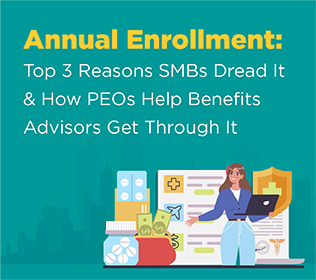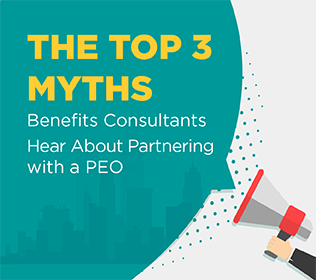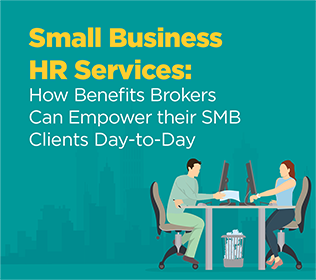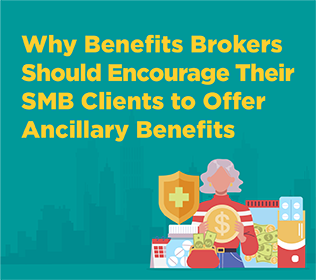
Employee benefits insurance brokers are highly attuned to the day-to-day operational burdens that their small and mid-size business (SMB) clients face every day. You, their trusted advisor, have a powerful tool in your arsenal that links your SMB clients to valuable HR resources and turnkey solutions: your partnership with a certified professional employer organization (PEO).
This article provides the winning insights and strategies you need to introduce and promote PEO services to key decision-makers within your SMB client base.
Defining the Landscape of PEOs (Professional Employer Organizations)
PEO services have the capacity to transform your clients’ approach to HR management, payroll processing, and compliance adherence, all while elevating employee satisfaction and helping you grow your own business. But before you and your clients can dig into the benefits of a PEO partnership, you must achieve the extraordinary: you must define “PEO.”
Professional employer organizations provide such a wide, seemingly complex array of services and business solutions, that the National Association of Professional Employer Organizations (NAPEO) surveyed trusted advisors from across the country to uncover the most effective messaging employee benefits brokers and other business consultants use.
To help simply and effectively communicate what a PEO is and the advantages it brings, we’ll take a look at PEO questions from SMB clients, feedback from the subjects of NAPEO’s tracking survey report, and provide additional data from other benefits advisors and industry leaders.

“What is a PEO?”
The short answer: PEOs are third-party organizations that save business owners and executives time by taking administrative and HR-related tasks off their plates, allowing them to instead focus on growing the success of their enterprises.
The detailed answer: PEOs work with small and medium-sized businesses (SMBs) to provide comprehensive HR solutions, help to ensure the companies are compliant with federal, state, and local regulations, and pay wages and taxes. Professional employer organizations can provide large group rates that small and midsize businesses typically don’t have access to.
These can include 401(k) plans, health, dental, life insurance, and other high-value ancillary benefits that have been shown to attract and retain top talent. By offering cost-effective HR administrative services, mitigating compliance risk, outsourcing payroll, managing workers’ compensation, and offering Fortune 500-caliber benefits, PEOs enable your SMB clients to actualize the full value of their time.

Broker Pointer #1: Some SMB Clients Need Help Identifying the Signs that they Need a PEO.
Some small and midsize business owners don’t intuitively know the full value a PEO partnership can provide and may need you to guide their attention toward key areas that may need support.
Four Questions to Prompt Your Client

Do you focus more on HR challenges than growing your sales revenue?

Are you aware of the new state-mandated 401(k) program?

Would you like to expand your benefits offerings beyond core medical plans?

Are you aware of SMB compliance risks associated with remote workers?
These questions are conversation starters that will help your client examine the “business as usual” headaches that SMB owners only concentrate on while they’re dealing with them in real time. Asking questions like these will provide your client with an opportunity to give more specific responses about their business’s unique needs.
This will also help you gain a more comprehensive understanding of the services they need the most. Very often, these conversations alert SMB owners to PEO services they didn’t know about, which will adeptly take a significant amount of tedious and time-consuming work off their plate once they enter a co-employment relationship with the right certified PEO.
“What is Co-Employment and How Does it Work?”
Employee benefits brokers help their SMB clients establish a co-employment relationship with their chosen PEO. This relationship contractually allocates certain employer responsibilities to the PEO via a client service agreement.
The professional employer organization agrees to take on a share of administrative employer responsibilities (such as payroll, HR administration, and risk management) while the client’s company retains complete control over employees and day-to-day operations. This arrangement between a PEO and the SMB owner shifts obligations and liabilities of employment to the PEO and creates cost and time savings for the business owner.

Broker Pointer #2: “Co-Employment” is not a bad word
Some clients check out of the conversation as soon as they hear “co-employment.” For this reason, it is crucial to ensure your clients understand that co-employment is NOT the same as co-ownership. Co-employment is about sharing business responsibilities, not sharing business ownership.
In approaching this topic with your client, it can be helpful to specify that PEO co-employment is a tool to leverage resources, not a concession of ownership. A great way to illustrate this is to explain that co-employment is the conduit for access to highly competitive employee benefits packages.
When your SMB owner enters a partnership with a PEO, their employees are incorporated under the PEO’s tax ID. This incorporation shifts the classification of your client’s insurance benefits from “small group” to “large group.”
Once backed by the strength of PEO co-employment, your client’s business is upgraded to the “large group insurance” category. Large group insurance offers greater negotiation power which results in more competitive rates, more flexible benefit plans, and can bring additional perks like a wider range of ancillary benefits.

“What Are Some PEO Pros and Cons?”
Managing all aspects of a business is difficult for many small and medium businesses. PEOs help businesses by using their own teams of highly skilled HR experts in the areas of payroll processing, HR administrative services, and employee benefits solutions. By law, co-employment is necessary for PEOs to take on these services, which may give your SMB clients pause.
To help your client make the most informed decision about a PEO partnership, here are a few PEO pros and cons for them to consider.
PRO: Co-Employment Means Reduced Liability
In partnership with the right professional employer organization, your clients can be confident that their payroll activities, workers’ compensation obligations, compliance, and risk management is being conducted by licensed experts.
CON: A New Co-Employment Partnership Can Require an Adjustment Period
The start of a new co-employment relationship can require a short adjustment period while your client and their employees get acclimated with their new, PEO-provided services. Highly experienced PEOs, such as PrestigePEO, offer extensive knowledge in delivering a seamless experience for clients and their employees. They offer valuable resources, informative presentations, and Q&A sessions to ensure employees comprehend the partnership and the anticipated benefits. Furthermore, dedicated in-house specialists will be designated to establish reliable points of contact, well-versed in your client’s business and their employees.
PRO: A PEO Partnership Will Save Your Clients Time and Money
The services professional employer organizations offer remove critical yet time-consuming tasks like managing multiple HR vendors, navigating employee management challenges, and deciphering and adhering to new labor laws. By carrying these burdens, your client will have much more time to focus on expanding their business.
CON: Potential Client Confusion
Clients’ employees can be confused when introduced to a new partner. However, this new PEO relationship quickly demonstrates the highly valuable day-to-day guidance and benefits administration support that employees and their dependents need.

Broker Pointer #3: Transparency is Key, Clarity Closes Deals
You should be as transparent as possible with your client while discussing the pros and cons of a PEO partnership. They should be well-informed about what to expect each step of the way.
One of the key elements of transparency is pricing. When selecting a PEO partner for you and your clients, consider a partner that shows line-by-line unbundled pricing to identify savings passed on to the client.
PrestigePEO consistently provides transparent, itemized pricing to foster trust and facilitate the beginning of a lasting partnership.
Finding The Ideal PEO Partner and Support For Your Clients
The best way to protect your relationship with your clients as you help them enter a co-employment relationship with a professional employer organization is to ensure that you find the best PEO possible. This generally includes checking to ensure the company is a member of the National Association of Professional Employer Organizations (NAPEO), holds the industry’s highest certifications and accreditations, and is capable of meeting your client’s needs.
This page may be a helpful primer for conversations with your current and potential clients. We know every small and medium-sized business has its intricacies, and every SMB owner will have a few questions that may even surprise an expert like you. Just as you’re acting as a benefits consultant and advisor to your clients, we’re here to provide you with that same support and guidance.
PrestigePEO was created by brokers, for brokers, keeping your needs in mind. We encourage you to keep in touch with us so we can help support you as you grow your own book of business and guide your clients toward success.
To learn more about how to start creating custom benefits packages for your clients, connect them to resources like our HR and benefits experts, and more, contact us online or by phone at 888-PEO-PEO1.




